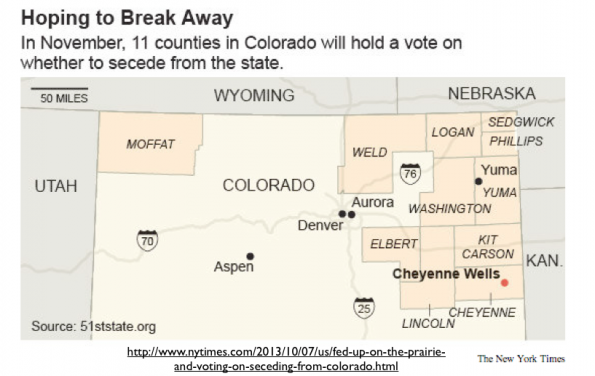Voters in 11 counties in northern Colorado are currently voting on whether to secede from their state and form the 51st state of North Colorado. This seems like a good opportunity to reflect on their chances for success and what such a state would actually look like.

Now, the first thing to point out is that counties can’t just break away and form a new state, even if that’s what their voters want. Yes, it’s possible that a majority of voters in all 11 counties will explicitly state that they want to secede, but that and three dollars will get you a pint of India Pale Ale from Crabtree Brewery (located in rebellious Weld County). Article 4, Section 3 of the U.S. Constitution is quite straightforward about the formation of new states:
New States may be admitted by the Congress into this Union; but no new State shall be formed or erected within the Jurisdiction of any other State; nor any State be formed by the Junction of two or more States, or Parts of States, without the Consent of the Legislatures of the States concerned as well as of the Congress.
In other words, the Colorado state legislature and the U.S. Congress would need to vote to make this happen. Generally speaking, it’s very uncommon for a state to willingly vote to make itself smaller. (The last time that happened was in 1862 when West Virginia broke off from Virginia, and that involved some creative wartime interpretations of the Constitution.) And the U.S. Congress seems no more likely to vote for such statehood. Would the Democratic-controlled Senate vote to create a state with a guaranteed two additional Republican senators while depleting the size of a Democratic state? Not likely.
But let’s say it happened. What would that state look like? Well, if we assumed that all 11 counties currently considering secession formed a new state, that state would be among the most conservative in the nation. Voter registration would run 56 percent Republican and 16 percent Democratic, with the rest independent or forming third parties. That state would have cast 74 percent of its 2012 presidential vote for Mitt Romney, second only to Utah in its Republican support.
North Colorado would contain just over 350,000 people, making it by far the smallest state in the union. (Neighboring Wyoming has over 550,000.) About 1.6 percent of its residents would identify as African American; 15 percent would be Latino. The state would have a median income of about $24,000. Its most populous city would be Greeley, with fewer than 100,000 residents.
This state would be overwhelmingly rural and not terribly wealthy. It would lack many of the attractions (ski resorts, waterways, mountains, etc.) that bring tourist dollars to Colorado, and it would be cut off from various forms of public support the region now receives from Denver. So why build it?
Because this is what frustrated minority party activists do when they see the other party taking control of the state government and moving the state in a direction that seems alien to them. In this case, it is a response to the Democratic-controlled state government enacting firearms restrictions and renewable energy requirements. More generally, it is a reaction to the rise of one-party rule and increasing party polarization. Secession is of a piece with the rise of state legislative recalls, the increasing use of the filibuster, and government shutdowns. If those tactics don’t get you the government you want, then leaving is the next option. Secession is the conservative equivalent of moving to Canada.
The likely result of all this is that it will just be seen as a protest vote and will go no further. But it should be remembered as something more than that. It represents a rejection of representative democracy. It’s a refutation of the idea that if you’re losing, you make better arguments, recruit better candidates, and run better campaigns until you win. It’s a statement: “If that’s the state you all want, you can build it without us.”





